Six Days in Niagara
Pevans reports from the 2013 Gathering of Friends
My report is written as a narrative to be read through and focuses on the new (to me) games I played. You can use the indexes below to take you to specific sections or games.
It is also available as a PDF document: Gathering of Friends 2013 report (4 Mb). (You will need Adobe Reader to view this document – use the link to download it if necessary.)
- Introduction – getting there
- Day 1 – Terra Mystica and more
- Day 2 – Love Letter and dinosaurs
- Day 3 – Spanish Main vs Arabia
- Day 4 – Clashing cultures and castaways
- Day 5 – Overlord and racing robots
- Wrapping up and getting home
- About the Gathering
- List of games
List of new (to me) games
| Title | Publisher/Distributor | Pevans's (highly subjective) rating |
|---|---|---|
| Al Rashid | Yemaia | 7/10 |
| Bora Bora | alea | 8/10 |
| Cinque Terre | Rio Grande Games | 7/10 |
| Clash of Cultures | Z-Man Games | 8/10 |
| Francis Drake | Eagle Games | 8/10 |
| Great Heartland Hauling Co | Dice Hate Me Games | 8/10 |
| Kalimambo | Zoch Verlag | 6/10 |
| Love Letter | AEG | 9/10 |
| Police Precinct | Common Man Games | 5/10 |
| Quarriors! | WizKids | 5/10 |
| Robinson Crusoe | Portal Games | 9/10 |
| Suburbia | Bezier Games | 8/10 |
| Terra Mystica | Z-Man Games | 7/10 |
| Triassic Terror | Kayal Games/Eagle Games | 7/10 |
| Tzolk'in | Czech Games Edition | 6/10 |
About the Gathering
This year’s event was the 24th Gathering of Friends, which started out as a weekend get-together by a bunch of gamers, led by Alan Moon (now well known as the designer of Airlines, Elfenland, Ticket to Ride et al). The following year they did it again, bringing some friends with them. This is the abiding principle of the Gathering of Friends: everybody who comes is a friend (and is invited by Alan). This makes for a very convivial, relaxed atmosphere in which anyone can walk up to anyone and ask to join or start a game. Never mind six degrees of separation; at the Gathering it’s hard to find someone more than two degrees away!
Over the years, the Gathering has expanded in time and space: the 2013 event had 370 attendees over nine full days (though not everybody was there for the whole time). It has moved, arriving in Niagara Falls in 2011 after several years in Columbus, Ohio. There is an increasing business element to the Gathering, as well. Games designers bring prototypes to test and show to the publishers who attend. However, the emphasis remains on playing games and having fun. The event would be recognisable to anyone who’s attended any gamer-organised convention in the UK. It consists of people playing games – most of which they’ve brought with them and made available to everyone else. I always have a good time.
Getting there
My transport arrangements to Niagara Falls are getting better. I was only two hours behind schedule arriving this year – much better than the 23 hours of two years ago! As always, flying internationally consists of a tedious progression of queues in various forms, enlivened only by the occasional movie or book. The result is that I was very pleased to arrive at the hotel for this year’s Gathering of Friends and get down to the serious business of playing games – and chatting to friends old and new.
I was quickly inveigled into playing Suburbia by an old Gathering friend, Steve Lesnik. Suburbia is the game Ted Alspach and Bezier Games launched at Spiel ’12. It was a sell-out at Spiel and this was the first chance I’d had to play it. Steve and I were joined by LPBS player Pete Card and George Michael (no, not that one). As the title suggests, the game is about developing your suburb to a notional city. The most noticeable thing about the game is the triangular central boards and the player’s boards with ‘bites’ taken out of them for hexagonal tiles to fit in. The hexagonal and circular tiles and wooden cubes and cylinders used in the game are much more familiar, in contrast.
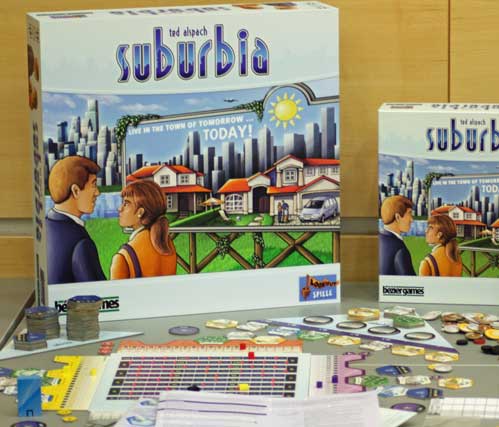
Suburbia on display at Spiel ’12 (photo by Mike Dommett)
Players start with an initial set of hexagonal tiles that represent their town. They will buy additional tiles – from the row of tiles that represents the real estate market – and place them to expand their town. The tiles are coloured to indicate their type with specific details given by the text and icons on the tile (not to mention the illustrations). When placed, tiles may change players’ ‘income’ or ‘Reputation’ (tracks on the players’ boards) according to both what they do and how they interact with other tiles – a clever touch. Both of these affect player’s ‘Population’, which is shown on the scoring track because Population is how you win the game!
On first acquaintance, I found Suburbia fascinating with some interesting twists on familiar mechanisms. It’s a game where you have to balance what you’re doing to get the best from your position. The group I played with felt that the game is a multi-player solitaire. That is, each participant plays their own game with no interaction with the others. I have no problem with this kind of game and I give it a provisional 8/10 on my highly subjective scale. The best news is that a second edition is on its way.
Terra Mystica and more
An early night was required on my first day at the Gathering, but I was up bright and early to start on some more games the following day. First, however, I was co-opted to explain the rules to Keyflower for a group of new players. With that out of the way, I could get on with playing something. Now, one of the features of the Gathering is the number of games designers trying out prototypes of new games. The rule is that we don’t publish anything about these, so I shall stay shtum on the neat game I played next.
The game I can talk about is Terra Mystica, which I know is a lot of people’s favourite of last year. I’d carefully avoided reading any reviews, though, and had somehow gained the impression that it was a card game. Boy was I wrong! Pete and I were joined by Nick Ramsey and Maryl Fischer for our introduction to the game (published by Z-Man Games).
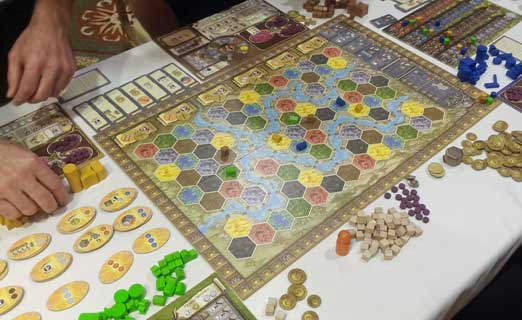
Completing the set-up of our game of Terra Mystica
Terra Mystica is a complex, strategy board game, which I will now summarise ... No, I give up! There is an awful lot going on in this game. In a distinct contrast to Suburbia, which has pretty simple rules, Terra Mystica’s rules are complicated. At the core, though, each player needs to get more of their buildings onto the board. Each building increases players’ income – not just in cash, but also workers, priests and magical power. The players are different fantasy races (dwarves, halflings et al) and each can only build in a particular terrain (forests, marshes, mountains and so on). However, they have to build next to their existing buildings, so must convert spaces to the right terrain.
That gives you a taste of the game. On top of this, players can improve their actions – or make them cheaper – by spending resources. Hence one decision each round is whether to spend resources on doing things now or use them to improve actions so that you can do more in subsequent rounds. There are only a limited number of rounds, so there’s time pressure as well. And bonus points are available each round, giving players an incentive to do specific actions on that round.
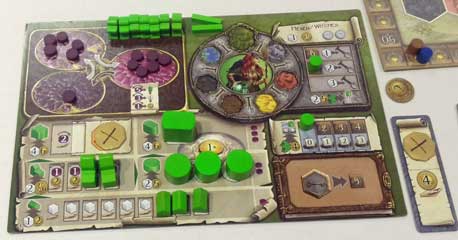
I was playing the green, forest-dwelling Witches – note the spaces left empty to show income from buildings played
Terra Mystica (designed by Jens Drögemüller and Helge Ostertag) is a game that has to be played in order to get to grips with, but it’s appealing enough that it’s fun the first time you play. It’s a clever, challenging game and I can see why so many gamers like it. I enjoyed the game (and have played it again since) and give it a provisional 7/10 on my highly subjective scale.
One of the discoveries of this year’s Gathering was The Culinary Institute, one block along the road at the side of the hotel. As part of its students’ training, the Institute runs a sandwich bar, a coffee shop and a fine restaurant (not to mention a wine merchant!). It quickly became a regular attraction for Gathering attendees, for both lunch and dinner.
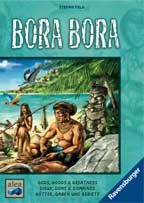 So, after a substantial lunch, it was back for another game. The game was Bora Bora, the latest from Stefan Feld and alea. My first thought was: colourful! The board shows a group of islands, each split into several areas, as is the sea between them. Players get to place their wooden ‘huts’ on the islands, pushing to one side any other player’s piece that’s already there. This is a neat mechanism as players want to get the most out of placing huts by doing so early on. However, they will only get the bonus for occupying areas at the end of the game if they’re the last to arrive.
So, after a substantial lunch, it was back for another game. The game was Bora Bora, the latest from Stefan Feld and alea. My first thought was: colourful! The board shows a group of islands, each split into several areas, as is the sea between them. Players get to place their wooden ‘huts’ on the islands, pushing to one side any other player’s piece that’s already there. This is a neat mechanism as players want to get the most out of placing huts by doing so early on. However, they will only get the bonus for occupying areas at the end of the game if they’re the last to arrive.
That’s just one of the things players can do, though. The actions available, including adding a new hut, are shown on the board. At the start of a round, players roll their dice. To take an action, players place a die on the action space. Generally, the more spots on the die, the more of that action the player can do. However, they can only place a die if it has fewer spots than any of the dice already on the space. Another neat mechanism! It also means that all values on the dice can be useful – ideally you want to roll a mixture of high and low values.
The game is just like this: packed full of clever tactical options that give players a lot to think about each round. One thing that you may not appreciate the first time you play is that the very useful end-of-game bonuses are tough. As the game has a set number of rounds, you need to commit to these on round one to have a good chance of getting them. Bora Bora is an ingenious game, but one that’s not too hard on the grey matter: I give it a provisional 8/10 on my highly subjective scale.
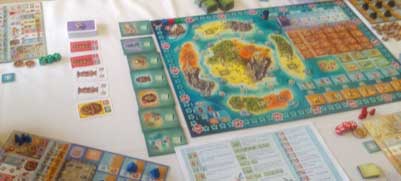
I told you it was colourful! Bora Bora in play
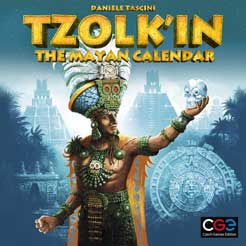 Spotting a game of Tzolk’in with room for another player, I invited myself in (hey, we’re all friends at the Gathering – in this case, Ed Bryan, Jim Vroom and Tom DeMarco, all of whom I know of old). This is the game from Czech Games Edition (designed by Simone Luciani and Daniele Tascini) that features several large, wooden, interlocking cogwheels on the board.
Spotting a game of Tzolk’in with room for another player, I invited myself in (hey, we’re all friends at the Gathering – in this case, Ed Bryan, Jim Vroom and Tom DeMarco, all of whom I know of old). This is the game from Czech Games Edition (designed by Simone Luciani and Daniele Tascini) that features several large, wooden, interlocking cogwheels on the board.
It turns out that the wheels are where you place your workers (pawns) to garner resources of various types. Each round, the wheels turn one notch, giving your workers more resources if you remove them. The question is how long you can let your workers ride... As players’ main choices of action are to place workers or remove workers, you have no choice if you run out – this is when having bought more workers is useful.
As you’d expect, the resources brought in by workers are used to buy things which will either get you more resources or victory points. The game has several neat mechanisms – and some neat pieces, like the crystal skulls that are one of the resources – but it boils down to another worker placement game with too many choices! It’s clear that players need to plan for several rounds because of the moving bits. I give it a provisional 6/10 on my highly subjective scale.
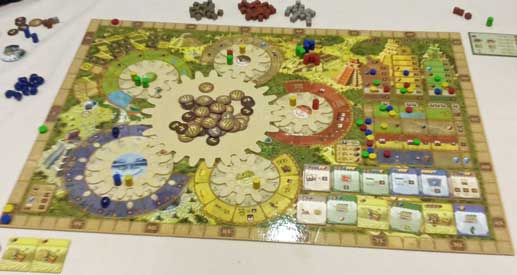
Playing Tzolk'in – I have no idea what's going on...
After which, Ed roped me in to a game of Quarriors! (from Wizkids and designed by Mike Elliott and Eric Lang) with a couple of other newbies. Now I’m not sure I fully grasped the rules – as we were guided by Ed’s expertise – but it’s a game where you summon monsters and use them to attack other players or defend against their monsters (hmm, that sounds familiar). What’s different is that Quarriors! is a bizarre dice rolling game.
The basic mechanism can be described as a dice game equivalent of Dominion. You play cards from your hand and then roll the dice granted to you by the cards. These give you attacks against an opponent or resources to buy more cards – which then recycle into your deck. Cards can also be spells for players to cast, giving players something else to think about. They get points for monsters that survive a round and the first to a specific total wins – unless the cards run out when the player with the most points wins.
I found the whole thing quite mad, but that may have been the lateness of the hour. Quarriors! seems to have been very successful – judging by the number of expansions that I see advertised. I give it a provisional 5/10 on my highly subjective scale.
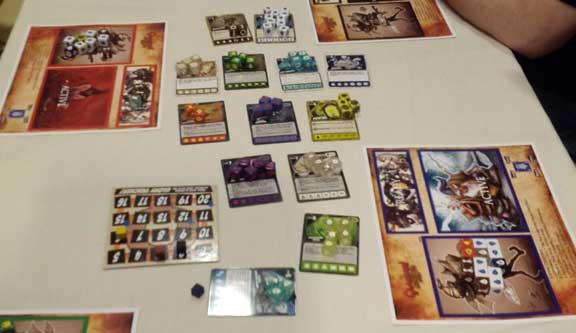
Quarriors! Cards, dice and player mats – and somebody’s elbow
Love Letter and dinosaurs
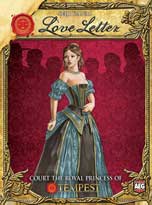 Wednesday started with Love Letter (designed by Seiji Kanai) and I am indebted to Brian Bankler for introducing me to this gem. This is a beautifully crafted little game: just 16 cards – and only eight different ones. Players start with one card each. They draw one and play one, taking the action shown on the card, until the deck runs out. The aim is to have the highest card at the end of the round – but you can get knocked out of the round! The other cards’ actions offer hints as to who’s holding what card, which influences what you play. The first player to win a set number of rounds wins the game.
Wednesday started with Love Letter (designed by Seiji Kanai) and I am indebted to Brian Bankler for introducing me to this gem. This is a beautifully crafted little game: just 16 cards – and only eight different ones. Players start with one card each. They draw one and play one, taking the action shown on the card, until the deck runs out. The aim is to have the highest card at the end of the round – but you can get knocked out of the round! The other cards’ actions offer hints as to who’s holding what card, which influences what you play. The first player to win a set number of rounds wins the game.
This is such an elegant game. It’s as if someone has taken a deck of cards and whittled it down to just the minimum necessary. Or perhaps a haiku is a better analogy – profundity in seventeen syllables (appropriate, given the Japanese designer). Just playing a few hands it was clear that there is some subtlety to the game and I could see people’s tactics evolving as they learned. The AEG version, which we were playing, looks absolutely gorgeous as well. It’s a cracking little game and gets a provisional 9/10 on my highly subjective scale.
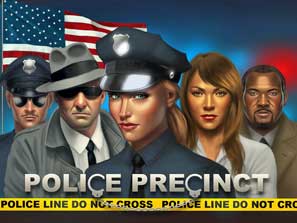
Time to catch up with some more Gathering friends – James and Sheila Davis and Herb Levy. This we did over a game of Police Precinct (designed by Ole Steiness and published by Common Man Games – a new name to me). This is a co-operative game of crime solving. The players are particular police characters, each with their own speciality. There’s a murder to solve. Players must find all the evidence while dealing with emergencies – which divert them from the main task, but cannot be ignored if they want to win – in a limited number of rounds.
The murderer shows up in the last few rounds, making a run for it across the board. To win the game, the players must have gathered all the evidence before they can intercept the murderer and make the arrest. There’s an option for one player to be a dirty cop in the pay of the bad guys. This makes the game even harder – and we lost without it. We were on the point of collecting the last piece of evidence, only to be tipped over the edge by the unresolved emergencies.
The game felt very constrained by the ‘plot’ and I’m not sure it has much replay value. Police Precinct certainly didn’t grab me in the way Flash Point did last year. It gets a provisional 5/10 on my highly subjective scale.
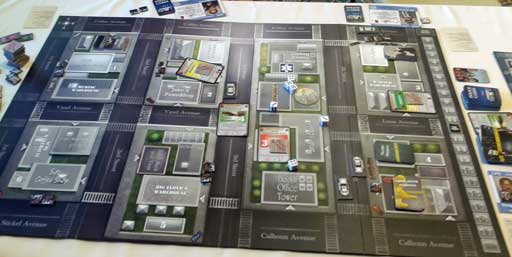
Police Precinct in play – the squad cars show where players are dealing with crimes
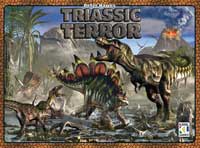 Who can say no to a game that involves stomping about the board with dinosaurs? No, me neither. I joined two old gaming buddies, Chris Kovac and Steffan O’Sullivan, and a new one, Paul Dupuis, to play Triassic Terror. This is Peter Hawes’s game from Kayal Games, a new publisher to me. The board is divided into areas of different terrain, each with three levels. Players marshal their herds of little wooden dinosaurs around these twelve regions.
Who can say no to a game that involves stomping about the board with dinosaurs? No, me neither. I joined two old gaming buddies, Chris Kovac and Steffan O’Sullivan, and a new one, Paul Dupuis, to play Triassic Terror. This is Peter Hawes’s game from Kayal Games, a new publisher to me. The board is divided into areas of different terrain, each with three levels. Players marshal their herds of little wooden dinosaurs around these twelve regions.
The stomping is done by the large, plastic Tyrannosaurus Rex and raptors, who dispose of smaller dinosaurs. Moving these is done by the players as part of one of the several actions available to them. The actions are denoted by a row of cardboard tiles and players take the tile for the action they want each round. Actions let them move their dinosaurs, add new dinos and so on. The crucial thing is that only one player gets each action in a round, so choosing the right one is key.
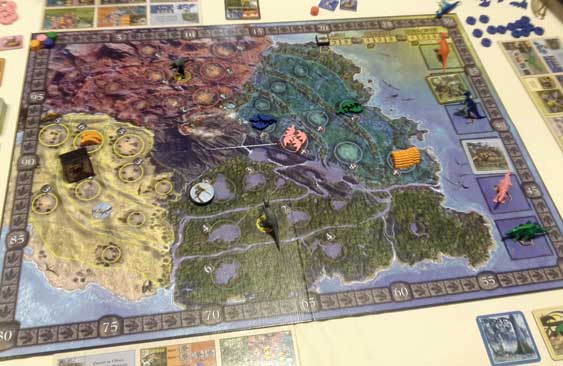
The end of the first round in Triassic Terror – note the large dinosaurs on the right where action tiles have been taken from
Triassic Terror is a fairly lightweight, fun game with some neat tactical options and a clever scoring mechanism. It’s played over a set number of rounds with a few scoring rounds mixed in. You could approach this game with your thinking cap on, but I treated it as a romp and had good fun. It gets a provisional 7/10 on my highly subjective scale.
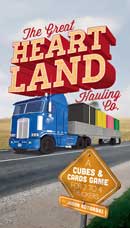 Meeting up with a couple more old friends, Joe Huber and Michael Tsuk, I was given a choice of types of game to play. I opted for pick up and deliver, a kind of game I enjoy a lot (all the way back to Auf Achse). Joe promptly produced The Great Heartland Hauling Co. This is an ingenious little card game from Dice Hate Me Games (produced as a Kickstarter project and designed by Jason Kotarski).
Meeting up with a couple more old friends, Joe Huber and Michael Tsuk, I was given a choice of types of game to play. I opted for pick up and deliver, a kind of game I enjoy a lot (all the way back to Auf Achse). Joe promptly produced The Great Heartland Hauling Co. This is an ingenious little card game from Dice Hate Me Games (produced as a Kickstarter project and designed by Jason Kotarski).
To start the game, a number of ‘Location’ cards are laid out to provide a network connected by roads. Each location shows the goods it produces – cubes are placed for these – and those it will buy. Players move their good-looking trucks between locations using fuel cards from their hand (or cash if the cards run out) to pick up cubes and deliver them where there’s a profit. However, they have to have the corresponding goods cards in hand both to pick up and to deliver.
Apart from the question of how best to get from A to B, players must also wrestle with the limits of what their truck will hold and how many goods each location will buy. There are some neat wrinkles to the game, but it’s not particularly demanding. I had good fun playing it – though this may have been the company I was with, as they were both in fine form! The Great Heartland Hauling Co gets a provisional 8/10 on my highly subjective scale.
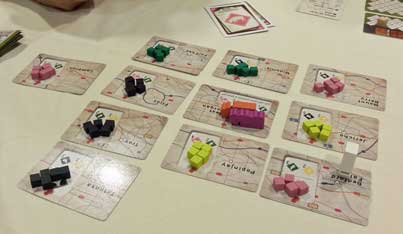
Playing The Great Heartland Hauling Co – note that we’ve each stood our truck on a different side so that we can tell them apart. Ahem.
You can tell you’re in America when the hotel you’re staying in doesn’t have a restaurant, it has a TGI Fridays. It doesn’t provide coffee, it has a Starbucks. Pete Card and I hit Fridays for dinner and were joined by Ed Bryan for a convivial meal.
Ed had expressed an interest in playing Pax Porfiriana, so Pete and I undertook to introduce him (we’re both fans). Stance Nixon joined us to make four and they managed to stop me winning until the last opportunity! Pete got his revenge by beating me at Innovation as our last game of the day.
Spanish Main vs Arabia
Several other people had stopped by our table to say they were interested in learning Pax Porfiriana, so Pete and I started Thursday as we finished Wednesday. This time our trainees were Dave Heberer, Aaron Curtis and Ray Pfeiffer. Dave is obviously a quick learner as he managed a quick win. This had whetted everybody’s appetites, so we played again. My winning streak is clearly at an end as Aaron won this time.
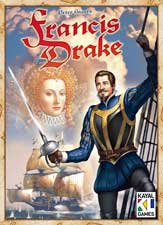 I’d been looking for the chance to try Peter Hawes’s very latest game as a fine-looking pre-production copy of Francis Drake was sitting on a table not far from us. Pete, Aaron and I seized our opportunity now and were joined by Derek Croxton to make four. The game is played on a big board, the main part of which is a map of the Caribbean, divided into areas according to how far they are from England and showing the town, forts and galleons that are the players’ targets.
I’d been looking for the chance to try Peter Hawes’s very latest game as a fine-looking pre-production copy of Francis Drake was sitting on a table not far from us. Pete, Aaron and I seized our opportunity now and were joined by Derek Croxton to make four. The game is played on a big board, the main part of which is a map of the Caribbean, divided into areas according to how far they are from England and showing the town, forts and galleons that are the players’ targets.
The rest of the board is a track that represents Plymouth harbour, where players outfit their ships for each expedition. This is a neat mechanism where players must choose how they want to equip their ship: how many guns, how big a crew, what trade goods? They key is that you can’t move back along the rack. So do you jump forward to get what you want or lag behind and only get the scraps? To provide variety, the printed track is replaced with tiles dealt at random in subsequent rounds.
Francis Drake is played over three voyages. Players equip their ships, hit their targets in the Caribbean – unless someone else gets there first – and return with their plunder. As we discovered, players really need to plan their expeditions from the off, deciding which targets to go for in what order. We had a lot of fun playing this and the result was a very close game. Francis Drake gets a provisional 8/10 on my highly subjective scale and I look forward to playing it some more when it’s published. (Expect it this autumn from Eagle Games.)
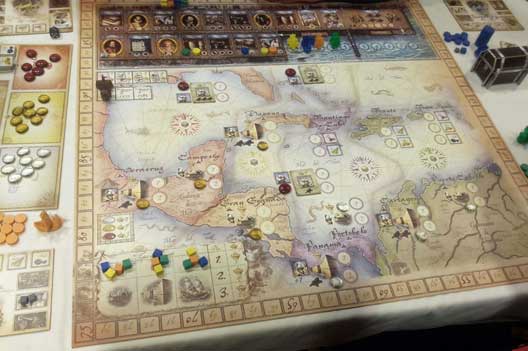
The Francis Drake board with the Plymouth track at the top
After a frustrating game of Bios Megafauna (the cards were wrong, the tiles were wrong and the climate was wrong – I was an evolutionary dead-end), it was time to eat. Peter Hawes joined Pete and me in Fridays for another pleasant dinner. Another prototype was followed by Traumfabrik, a typically clever Reiner Knizia auction game that I haven’t played for quite a while. I was able to exploit being the odd man out in a group of friends to sneak a win!
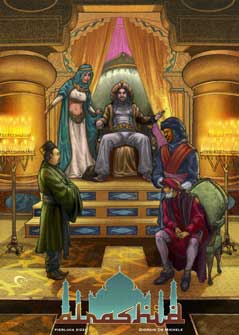 To round off the day, I got Kris Gould (main man at Wattsalpoag) to introduce me (and a couple of others) to game that looked interesting at Spiel: Al Rashid (designed by Giorgio de Michele and Pierluca Zizzi and published by Yemaia, a new Italian publisher). Not least because of the mock-Arabic font that’s mainly used for titles and headings. In practice, the font turned out to be a bit irritating as it means some text on the cards is difficult to read.
To round off the day, I got Kris Gould (main man at Wattsalpoag) to introduce me (and a couple of others) to game that looked interesting at Spiel: Al Rashid (designed by Giorgio de Michele and Pierluca Zizzi and published by Yemaia, a new Italian publisher). Not least because of the mock-Arabic font that’s mainly used for titles and headings. In practice, the font turned out to be a bit irritating as it means some text on the cards is difficult to read.
First each round, players place their pawns onto the lands shown on the board and/or the city palaces. Players are effectively bidding for the use of the area and their pawns have different values. Then they resolve the areas, one at a time. The lands may involve a battle before players can take the goods available there. The palaces allow players to buy things: more pawns for a start, but also hiring mercenaries (for the battles) and buying ‘titles’, each of which provides some advantage to the owner.
The game has some interesting tactical nuances: choosing the order to activate areas, overbidding your opponents and so on. It’s another pleasant game with a lot of options: you need military strength, you need goods, you need extra pawns and you need bonuses, but you can’t do everything. This gives you a lot of decisions to make. I give Al Rashid a provisional 7/10 on my highly subjective scale and look forward to playing it some more.
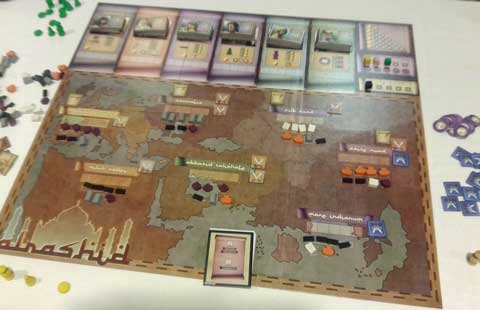
Playing Al Rashid
Clashing cultures and castaways
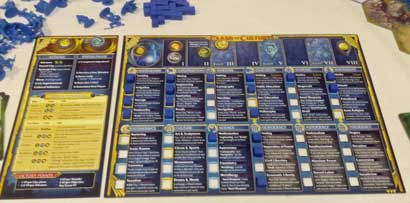 Friday began with a game I really wanted to play: Clash of Cultures from Z-Man Games (designed by Christian Marcussen). I’m a sucker for civilisation development/expansion games and joined some old friends, Ralph Anderson and Leo Tischer, to try this out. Each player starts with the beginnings of a city in a small territory. Between them lies unexplored land. As you’d expect, the players explore, build and, perhaps, fight.
Friday began with a game I really wanted to play: Clash of Cultures from Z-Man Games (designed by Christian Marcussen). I’m a sucker for civilisation development/expansion games and joined some old friends, Ralph Anderson and Leo Tischer, to try this out. Each player starts with the beginnings of a city in a small territory. Between them lies unexplored land. As you’d expect, the players explore, build and, perhaps, fight.
Two things really make the game. The first is the technology development. Each player has a separate board (see right – I was playing blue) to track their technology in a dozen different areas. Each of these provides players with advantages (and some disadvantages) that help them develop their ‘culture’ in particular directions. The other thing is the terrific playing pieces. I particularly like the buildings that fit together so that a full set makes a complete city.
All the different technologies make this a complicated game, though it’s surprisingly easy to pick up on your first playing. All in all, Clash of Cultures is an excellent empire development game with some really clever touches. Our game had limited conflict, but lots of development. I’m smitten: it gets a provisional 8/10 on my highly subjective scale.
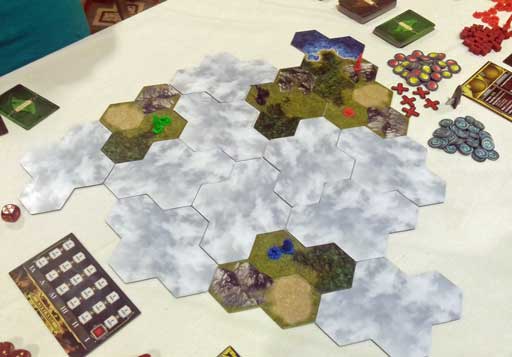
Starting the Clash of Cultures – look at all that unexplored land!
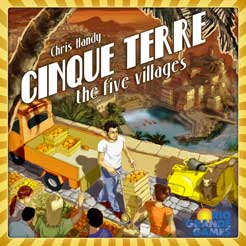 After a complicated game, it must be time for something simple. Steffan O’Sullivan recruited me to learn Cinque Terre (designed by Chris Handy, published by Rio Grande) with him. This is a brightly coloured, simple game of delivering fruit and veg on the Italian Riviera. No, really!
After a complicated game, it must be time for something simple. Steffan O’Sullivan recruited me to learn Cinque Terre (designed by Chris Handy, published by Rio Grande) with him. This is a brightly coloured, simple game of delivering fruit and veg on the Italian Riviera. No, really!
Key to the game are the wooden models of the motorised carts that transport your goods. The game rules tell you to put the cubes on your board, but they fit nicely on the backs of the carts. So that’s what we did! The heart of the game is actually the cards that show orders for a particular mix of goods to be delivered to specific villages. In addition, players can sell goods that correspond to the coloured dice set out at the villages.
Game play is quite quick as there’s only one thing to do each round. Despite its lightness, there’s more to Cinque Terre than initially meets the eye – I should certainly have taken it more seriously! It’s an excellent filler for gamers and a fine family game. It gets a provisional 7/10 on my highly subjective scale.
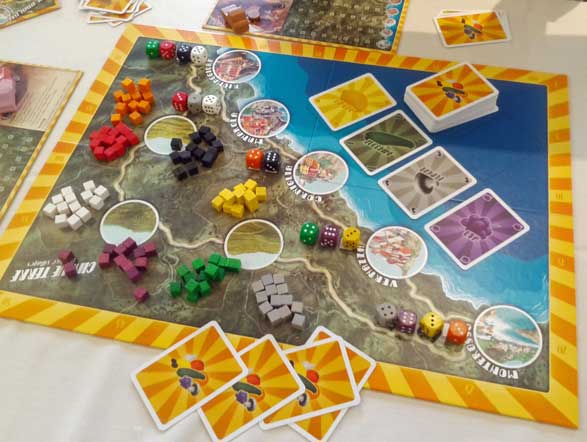
Cinque Terre set up and ready to go
Friday evening saw me – and several others – battle against a fierce wind to get a couple of hundred yards down the road and dine at the Culinary Institute. The food was excellent, as was the company. One thing I didn’t expect was that the restaurant would serve a range of locally-brewed beers. Not only that, but they offered a tasting selection so that I could try them all. Excellent stuff.
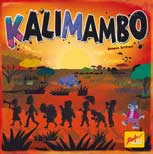 Returning to the games, I was introduced to Kalimambo, one of the many fun family games produced by Zoch (this one is designed by Antonio Scrittore). This one dates from 2011 and has a procession of wooden pawns trotting round the board, trying not to be bumped by Mambo the rhino! Each round, players pick and play one of their set of cards. Once revealed, they all move in the order given by the cards. A tie means only the rearmost of the tied players moves!
Returning to the games, I was introduced to Kalimambo, one of the many fun family games produced by Zoch (this one is designed by Antonio Scrittore). This one dates from 2011 and has a procession of wooden pawns trotting round the board, trying not to be bumped by Mambo the rhino! Each round, players pick and play one of their set of cards. Once revealed, they all move in the order given by the cards. A tie means only the rearmost of the tied players moves!
Then the rhino charges the back of the group, giving the player in last place penalty points according to how far it moved. Landing your pawn in a dung heap is penalty points too! When all the cards have been played, the player with the fewest points wins.
Okay, it’s not rocket science, but there are things to think about. Played in the right way, it’s good fun – a good after-dinner game. I give it 6/10 on my highly subjective scale.
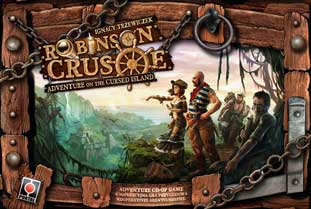 I finished Friday with something rather more demanding: Portal Games’s co-operative Robinson Crusoe (designed by Ignacy Trzewiczek). Having played before, Kris Gould did the honours and led a team of first-time shipwreckees (if that’s a word – spellcheck says “No”) onto the shores of the traditional desert island. Though it’s probably more of a mysterious tropical island – without any sign of polar bears, luckily.
I finished Friday with something rather more demanding: Portal Games’s co-operative Robinson Crusoe (designed by Ignacy Trzewiczek). Having played before, Kris Gould did the honours and led a team of first-time shipwreckees (if that’s a word – spellcheck says “No”) onto the shores of the traditional desert island. Though it’s probably more of a mysterious tropical island – without any sign of polar bears, luckily.
The large board is only partly taken up with a map – which starts blank except for the beach on which the players have just washed up. This is not all bad news as the beach does provide some food. However, the necessities of life take over. You need water, food and shelter. And food has this habit of running out (harvested all those bananas?) or going bad. You realise how necessary shelter is the first time a storm hits the island!
The rest of the board has spaces for the different hazards that face the players (wild animals, for one) and the various things they may be able to make to help them: a lantern, maybe, or a shovel… Each player also has a board to show the specifics of what is happening to their character and what they can do.
Each round starts with, in effect, a team meeting where the players decide who’s going to do what that day. This is a brilliant way of handling a co-operative game and allows the players to take into account their different strengths as well as the urgencies of each day. You’d always like to send the team’s best explorer to explore. However, if they’re sick, they need to spend the day in the camp and someone else will have to go exploring.
Robinson Crusoe is a tough and highly atmospheric game. There’s a real sense of a narrative running through the game, focused on the issues confronting the shipwrecked players. What’s more, the game provides several different scenarios. We were playing the basic scenario where all we had to do was survive, but the others put additional pressures on the players. It’s absolutely brilliant and a demanding challenge: it gets a provisional 9/10 on my highly subjective scale.
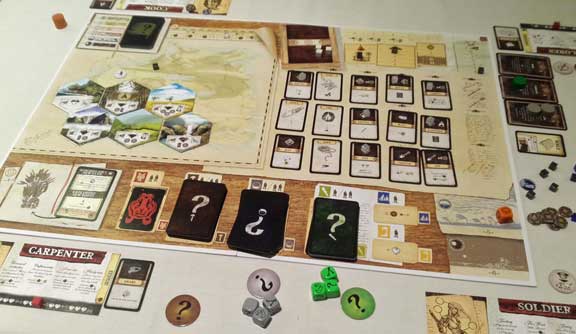
Playing Robinson Crusoe – we’ve explored a bit of the island
Overlord and racing robots
Saturday started with Kris Gould’s wonderful racing echidna game! It’s a prototype, so I shouldn’t talk about it, but it is great fun. However, this is mainly because of the enormous playing pieces and it’s unlikely they’d feature in a published version. Shame.
One of the regular events at the Gathering is that James and Sheila Davis organise an ‘Overlord’ game of Memoir 44. Overlord uses two boards in a row with three battlefield Generals (commanding the left flank, right flank or centre) plus a commander-in-chief for each side. The commanders-in-chief draw the Command cards and assign cards to, at most, two of their Generals – the third can roll a die to act on their own initiative. This is a rather different way of playing Memoir 44 and is great fun.
I managed to squeeze into this year’s game, which used a scenario from the Equipment Pack expansion, “High Stakes at Bruyères”. Historically, this is a battle in the Vosges Mountains from October 1944. In game terms, it includes some special units (Priest mobile artillery, Nebelwerfer rocket launchers, a Tiger tank and others) from the Equipment Pack, which gave us something different to work with.
I was assigned to command the centre for the Allies under our c-in-c, Mario Pawlowski. My sector featured the gap between the two US Infantry Divisions represented on the Allied side! I grabbed some armour from both to see off the tanks and tank destroyers (Panzerjäger) of my Axis opponent, Sheila – whose boss was James.
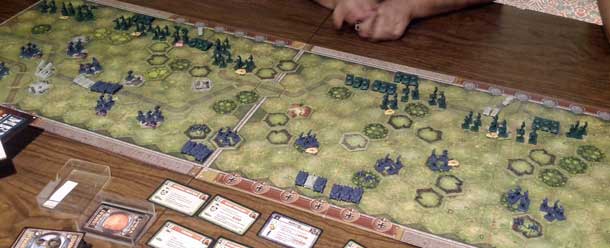
The Overlord game ready to start. See that gap in the Allied line (top)? That’s my command!
I was able to take ground from Sheila’s forces, occupying part of the town that was our objective. Leo Tischer had the Allied left flank and trounced his opposite number, but Terry Egan, on my right, had less success trying to throw the Axis forces out of main part of the town – and defeat that Tiger! The result was a (narrow!) win for the Axis as they held onto the town. Good fun was had by all – thanks to my teammates and opponents.
The game finished just in time for me to join in a blast from the past: a game of Roborally. If you haven’t come across it, this is a game of racing robots across the hazards of a factory floor and is huge fun. The twist is that you have to program the five actions for your robot at the start of each round. If things don’t go to plan, mayhem ensues! Thinking about it, mayhem generally ensues even if things do go to plan, with robots zapping each other with their lasers, pushing each other down pits and falling off conveyor belts.
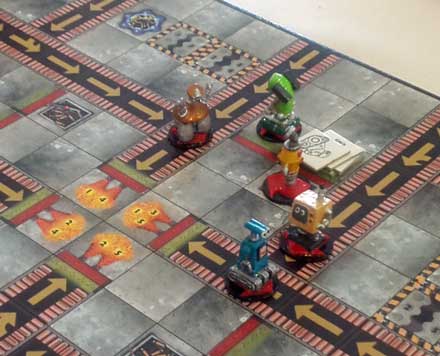 I raced Mark Geary, Kris Gould, Ann Lesnik (whose beautifully painted robots I think we were using) and Stance and Cheryl Nixon (fellow castaways from the evening before). We played on just two boards, following a figure-of-eight route that ensured we would get in each other’s way. Much zapping, crushing and bumping of robots later, I hit the finish line in first place.
The trick is concentrating on the race. And getting lucky! It was good fun, not least because of the company: thanks, guys.
I raced Mark Geary, Kris Gould, Ann Lesnik (whose beautifully painted robots I think we were using) and Stance and Cheryl Nixon (fellow castaways from the evening before). We played on just two boards, following a figure-of-eight route that ensured we would get in each other’s way. Much zapping, crushing and bumping of robots later, I hit the finish line in first place.
The trick is concentrating on the race. And getting lucky! It was good fun, not least because of the company: thanks, guys.
Brightly coloured robots, conveyor belts, flamethrowers… it must be Roborally!
This took us to the climax of the Gathering: the prize ceremony. Alan Moon talks briefly about the event, thanking all of those who help make it happen – which is much appreciated by all of us who just attend. Then there is the prize table, which is a feature of the Gathering. Everybody is encouraged to bring something (generally a game, of a quality that they would be happy to receive) for the prize table and everybody gets to take something away with them. The winners of the formal tournaments get to pick first and then everybody else chooses, in a random order. My choice this year was a pack of the Asmadi Games edition of Innovation (which I prefer to the one from Iello) and its two expansions. Excellent – and already in use at Swiggers.
With the prizes out of the way, the Gathering begins to wind down, with people packing up and saying their goodbyes. Pete Card and I adjourned to the bar and joined a multi-national group of drinkers. By my reckoning we definitely had Americans, Brits (strictly speaking, an Englishman and a Welshman), French, German and Norwegians and there may have been a Canadian and a Czech sneaking in as well.
7 Wrap-up
Sunday has a real end-of-term feeling as many people leave on Saturday evening or early in the morning. The piles of games are much smaller and sparser and the hotel is beginning to restore some of the rooms to their normal layout. There are still plenty of people about, though (and a sizable contingent stays until Monday).
I got in a game of powerboat racing game, Powerboats (one of Corné van Moorsel’s clever games) before taking part in the final tournament of the week, Can’t Stop. This is traditionally the last event of the Gathering and just about everybody who’s still there takes part. Can’t Stop is a terrific push-you-luck game which I really enjoy. I made it to the second round, only to go down to the eventual tournament winner, Mark Jackson.
This got a bit tense as I had to hold the taxi to the airport while Mark finished his game as he was one of the people sharing it! We were all there in good time for our flights, though. In fact, the return journey went without a hitch, my flight landing in Heathrow a good twenty minutes ahead of schedule. And that was that for another year: lots of excellent games played and much fun had!
Many thanks to Alan Moon and team for all their hard work and I look forward to seeing everybody next year.
An edited version of this article was first published in To Win Just Once issue 135 (June 2013).
